2004 ISUZU TF SERIES fuel
[x] Cancel search: fuelPage 1613 of 4264
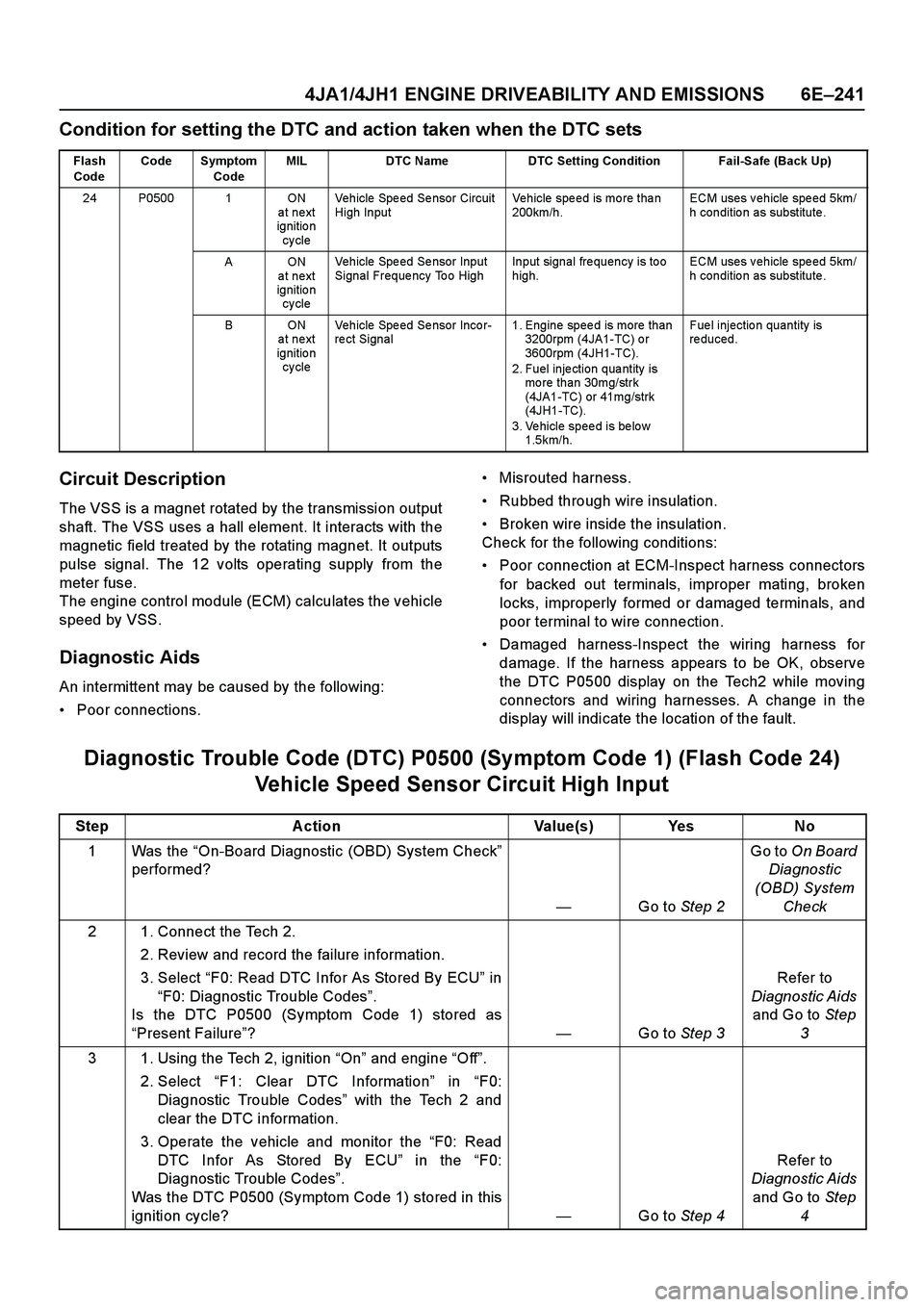
4JA1/4JH1 ENGINE DRIVEABILITY AND EMISSIONS 6E–241
Condition for setting the DTC and action taken when the DTC sets
Circuit Description
The VSS is a magnet rotated by the transmission output
shaft. The VSS uses a hall element. It interacts with the
magnetic field treated by the rotating magnet. It outputs
pulse signal. The 12 volts operating supply from the
meter fuse.
The engine control module (ECM) calculates the vehicle
speed by VSS.
Diagnostic Aids
An intermittent may be caused by the following:
Poor connections.Misrouted harness.
Rubbed through wire insulation.
Broken wire inside the insulation.
Check for the following conditions:
Poor connection at ECM-Inspect harness connectors
for backed out terminals, improper mating, broken
locks, improperly formed or damaged terminals, and
poor terminal to wire connection.
Damaged harness-Inspect the wiring harness for
damage. If the harness appears to be OK, observe
the DTC P0500 display on the Tech2 while moving
connectors and wiring harnesses. A change in the
display will indicate the location of the fault.
Diagnostic Trouble Code (DTC) P0500 (Symptom Code 1) (Flash Code 24)
Vehicle Speed Sensor Circuit High Input
Flash
CodeCode Symptom
CodeMIL DTC Name DTC Setting Condition Fail-Safe (Back Up)
24 P0500 1 ON
at next
ignitio n
cy cleVehicle Spe ed Se nsor Circuit
High InputVehicle speed is more than
200km/h.ECM uses v ehicle spe ed 5km/
h condition as substitute.
AON
at next
ignitio n
cy cleVehicle Speed Sensor Input
Signal Frequency Too HighInput signal frequency is too
high.ECM uses v ehicle spe ed 5km/
h condition as substitute.
BON
at next
ignitio n
cy cleVehicle Spe ed Se nsor Inco r-
re ct Signal1. Engine speed is more than
3200rpm (4JA1-TC) o r
3600rpm (4JH1-TC).
2. Fuel injection quantity is
more than 30mg/strk
(4JA1-TC) or 41mg/strk
(4JH1-TC).
3. Vehicle speed is below
1.5km/h.Fuel injection quantity is
re duced.
Step Action Value(s) Yes No
1Was the “On-Board Diagnostic (OBD) System Check”
performed?
—Go to Step 2Go to On Board
Diagnostic
(OBD) System
Check
2 1. Connect the Tech 2.
2. Review and record the failure information.
3. Select “F0: Read DTC Infor As Stored By ECU” in
“F0: Diagnostic Trouble Codes”.
Is the DTC P0500 (Symptom Code 1) stored as
“Present Failure”?—Go to Step 3Refer to
Diagnostic Aids
and Go to Step
3
3 1. Using the Tech 2, ignition “On” and engine “Off”.
2. Select “F1: Clear DTC Information” in “F0:
Diagnostic Trouble Codes” with the Tech 2 and
clear the DTC information.
3. Operate the vehicle and monitor the “F0: Read
DTC Infor As Stored By ECU” in the “F0:
Diagnostic Trouble Codes”.
Was the DTC P0500 (Symptom Code 1) stored in this
ignition cycle?—Go to Step 4Refer to
Diagnostic Aids
and Go to Step
4
Page 1637 of 4264
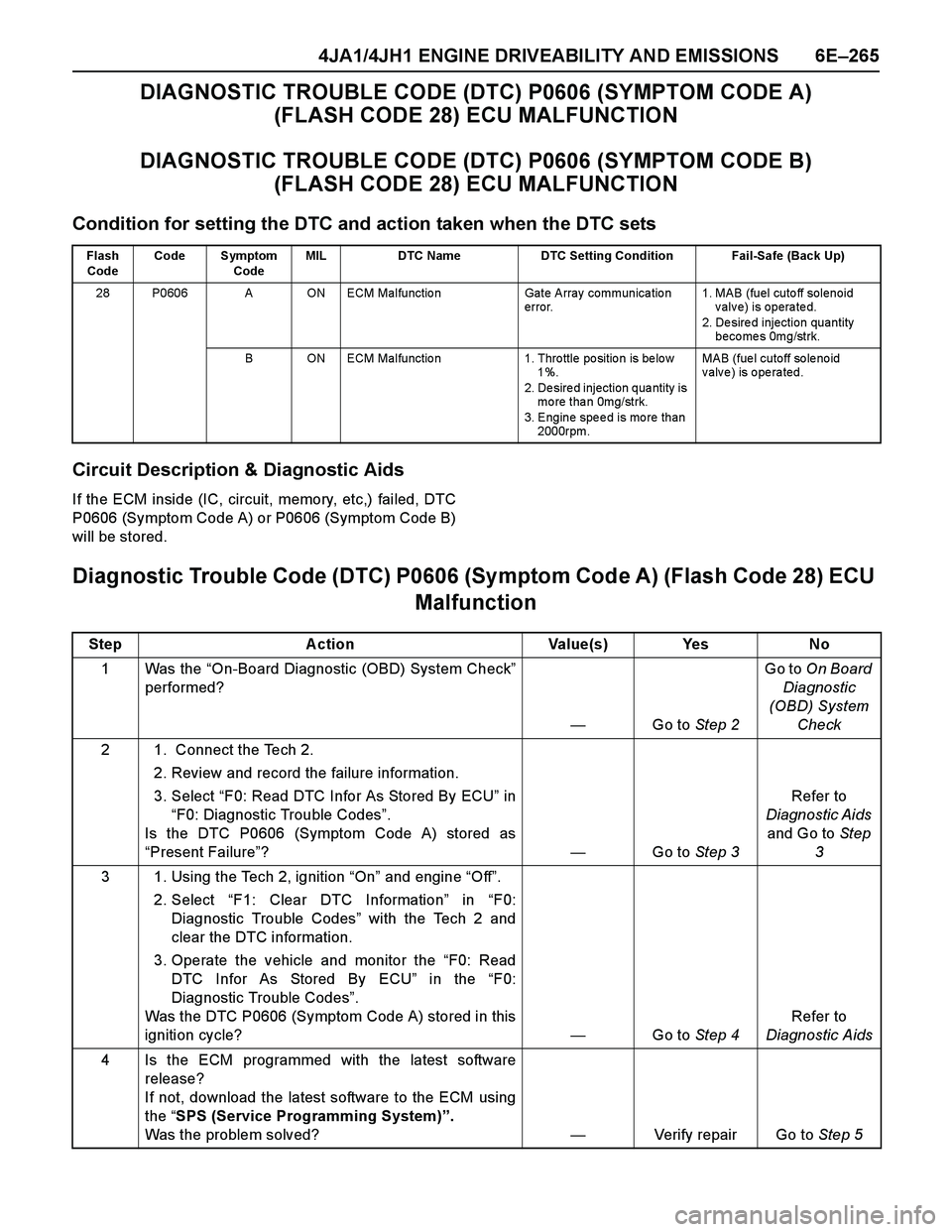
4JA1/4JH1 ENGINE DRIVEABILITY AND EMISSIONS 6E–265
DIAGNOSTIC TROUBLE CODE (DTC) P0606 (SYMPTOM CODE A)
(FLASH CODE 28) ECU MALFUNCTION
DIAGNOSTIC TROUBLE CODE (DTC) P0606 (SYMPTOM CODE B)
(FLASH CODE 28) ECU MALFUNCTION
Condition for setting the DTC and action taken when the DTC sets
Circuit Description & Diagnostic Aids
If the ECM inside (IC, circuit, memory, etc,) failed, DTC
P0606 (Symptom Code A) or P0606 (Symptom Code B)
will be stored.
Diagnostic Trouble Code (DTC) P0606 (Symptom Code A) (Flash Code 28) ECU
Malfunction
Flash
CodeCode Symptom
CodeMIL DTC Name DTC Setting Condition Fail-Safe (Back Up)
28 P0606 A ON ECM Malfunctio n Gate Array communica tio n
error.1. MAB (fuel cutoff solenoid
valve) is operated.
2. Desired injection quantity
becomes 0mg/strk.
B ON ECM Malfunctio n 1. Thro ttle po sitio n is be lo w
1%.
2. De sire d injection qua ntity is
more than 0mg/strk.
3. Engine speed is more than
2000rpm. MAB (fue l cutoff so le no id
valve) is operated.
Step Action Value(s) Yes No
1Was the “On-Board Diagnostic (OBD) System Check”
performed?
—Go to Step 2Go to On Board
Diagnostic
(OBD) System
Check
2 1. Connect the Tech 2.
2. Review and record the failure information.
3. Select “F0: Read DTC Infor As Stored By ECU” in
“F0: Diagnostic Trouble Codes”.
Is the DTC P0606 (Symptom Code A) stored as
“Present Failure”?—Go to Step 3Refer to
Diagnostic Aids
and Go to Step
3
3 1. Using the Tech 2, ignition “On” and engine “Off”.
2. Select “F1: Clear DTC Information” in “F0:
Diagnostic Trouble Codes” with the Tech 2 and
clear the DTC information.
3. Operate the vehicle and monitor the “F0: Read
DTC Infor As Stored By ECU” in the “F0:
Diagnostic Trouble Codes”.
Was the DTC P0606 (Symptom Code A) stored in this
ignition cycle?—Go to Step 4Refer to
Diagnostic Aids
4 Is the ECM programmed with the latest software
release?
If not, download the latest software to the ECM using
the “SPS (Service Programming System)”.
Was the problem solved?—Verify repair Go to Step 5
Page 1674 of 4264
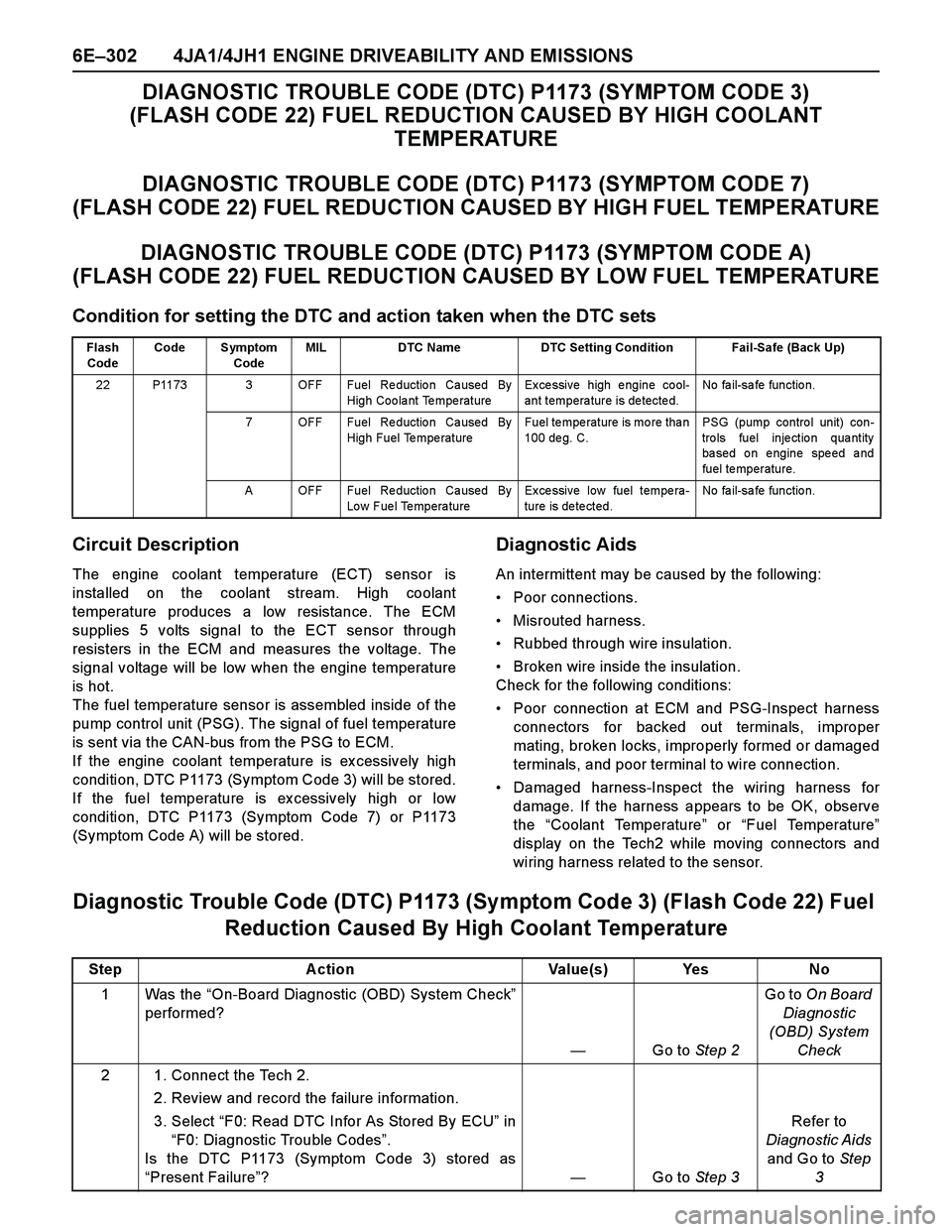
6E–302 4JA1/4JH1 ENGINE DRIVEABILITY AND EMISSIONS
DIAGNOSTIC TROUBLE CODE (DTC) P1173 (SYMPTOM CODE 3)
(FLASH CODE 22) FUEL REDUCTION CAUSED BY HIGH COOLANT
TEMPERATURE
DIAGNOSTIC TROUBLE CODE (DTC) P1173 (SYMPTOM CODE 7)
(FLASH CODE 22) FUEL REDUCTION CAUSED BY HIGH FUEL TEMPERATURE
DIAGNOSTIC TROUBLE CODE (DTC) P1173 (SYMPTOM CODE A)
(FLASH CODE 22) FUEL REDUCTION CAUSED BY LOW FUEL TEMPERATURE
Condition for setting the DTC and action taken when the DTC sets
Circuit Description
The engine coolant temperature (ECT) sensor is
installed on the coolant stream. High coolant
temperature produces a low resistance. The ECM
supplies 5 volts signal to the ECT sensor through
resisters in the ECM and measures the voltage. The
signal voltage will be low when the engine temperature
is hot.
The fuel temperature sensor is assembled inside of the
pump control unit (PSG). The signal of fuel temperature
is sent via the CAN-bus from the PSG to ECM.
If the engine coolant temperature is ex cessively high
condition, DTC P1173 (Symptom Code 3) will be stored.
If the fuel temperature is ex cessively high or low
condition, DTC P1173 (Symptom Code 7) or P1173
(Symptom Code A) will be stored.
Diagnostic Aids
An intermittent may be caused by the following:
Poor connections.
Misrouted harness.
Rubbed through wire insulation.
Broken wire inside the insulation.
Check for the following conditions:
Poor connection at ECM and PSG-Inspect harness
connectors for backed out terminals, improper
mating, broken locks, improperly formed or damaged
terminals, and poor terminal to wire connection.
Damaged harness-Inspect the wiring harness for
damage. If the harness appears to be OK, observe
the “Coolant Temperature” or “Fuel Temperature”
display on the Tech2 while moving connectors and
wiring harness related to the sensor.
Diagnostic Trouble Code (DTC) P1173 (Symptom Code 3) (Flash Code 22) Fuel
Reduction Caused By High Coolant Temperature
Flash
CodeCode Symptom
CodeMIL DTC Name DTC Setting Condition Fail-Safe (Back Up)
22 P1173 3 OFF Fuel Reduction Caused By
High Coolant TemperatureExcessive high engine cool-
ant temperature is detected.No fa il-sa fe fun ctio n.
7 OFF Fuel Re ductio n Ca used By
High Fuel TemperatureFuel te mpe rature is mo re tha n
100 de g. C.PSG (pump contro l unit) con-
tro ls fuel inje ctio n qua ntity
based on engine speed and
fuel temperature.
A OFF Fuel Re ductio n Ca used By
Low Fuel TemperatureExcessive low fuel tempera-
ture is de te cted.No fa il-sa fe fun ctio n.
Step Action Value(s) Yes No
1Was the “On-Board Diagnostic (OBD) System Check”
performed?
—Go to Step 2Go to On Board
Diagnostic
(OBD) System
Check
2 1. Connect the Tech 2.
2. Review and record the failure information.
3. Select “F0: Read DTC Infor As Stored By ECU” in
“F0: Diagnostic Trouble Codes”.
Is the DTC P1173 (Symptom Code 3) stored as
“Present Failure”?—Go to Step 3Refer to
Diagnostic Aids
and Go to Step
3
Page 1677 of 4264
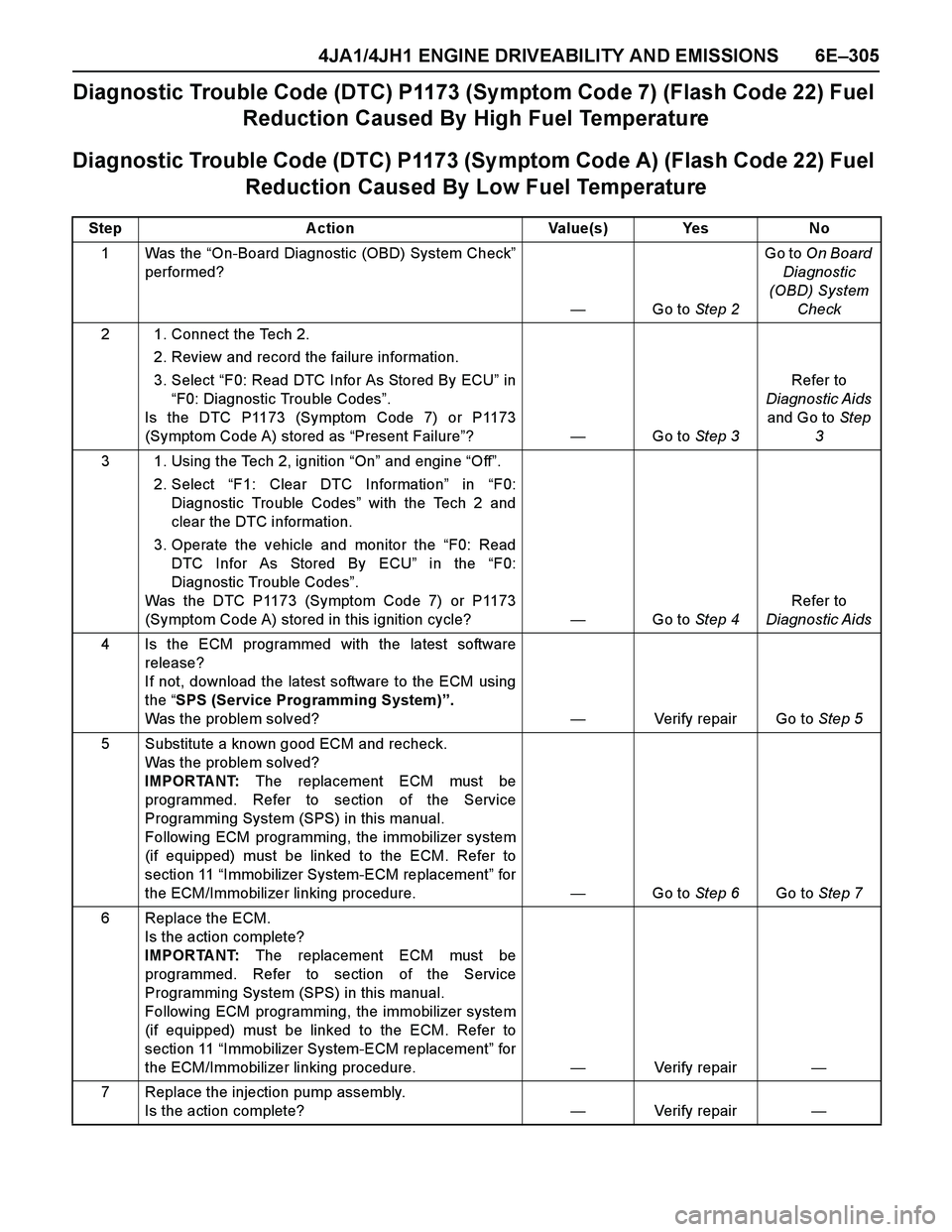
4JA1/4JH1 ENGINE DRIVEABILITY AND EMISSIONS 6E–305
Diagnostic Trouble Code (DTC) P1173 (Symptom Code 7) (Flash Code 22) Fuel
Reduction Caused By High Fuel Temperature
Diagnostic Trouble Code (DTC) P1173 (Sy mptom Code A) (Flash Code 22) Fuel
Reduction Caused By Low Fuel Temperature
Step Action Value(s) Yes No
1Was the “On-Board Diagnostic (OBD) System Check”
performed?
—Go to Step 2Go to On Board
Diagnostic
(OBD) System
Check
2 1. Connect the Tech 2.
2. Review and record the failure information.
3. Select “F0: Read DTC Infor As Stored By ECU” in
“F0: Diagnostic Trouble Codes”.
Is the DTC P1173 (Symptom Code 7) or P1173
(Symptom Code A) stored as “Present Failure”?—Go to Step 3Refer to
Diagnostic Aids
and Go to Step
3
3 1. Using the Tech 2, ignition “On” and engine “Off”.
2. Select “F1: Clear DTC Information” in “F0:
Diagnostic Trouble Codes” with the Tech 2 and
clear the DTC information.
3. Operate the vehicle and monitor the “F0: Read
DTC Infor As Stored By ECU” in the “F0:
Diagnostic Trouble Codes”.
Was the DTC P1173 (Symptom Code 7) or P1173
(Symptom Code A) stored in this ignition cycle?—Go to Step 4Refer to
Diagnostic Aids
4 Is the ECM programmed with the latest software
release?
If not, download the latest software to the ECM using
the “SPS (Service Programming System)”.
Was the problem solved?—Verify repair Go to Step 5
5 Substitute a known good ECM and recheck.
Was the problem solved?
IMPORTANT: The replacement ECM must be
programmed. Refer to section of the Service
Programming System (SPS) in this manual.
Following ECM programming, the immobilizer system
(if equipped) must be linked to the ECM. Refer to
section 11 “Immobilizer System-ECM replacement” for
the ECM/Immobilizer linking procedure. —Go to Step 6Go to Step 7
6 Replace the ECM.
Is the action complete?
IMPORTANT: The replacement ECM must be
programmed. Refer to section of the Service
Programming System (SPS) in this manual.
Following ECM programming, the immobilizer system
(if equipped) must be linked to the ECM. Refer to
section 11 “Immobilizer System-ECM replacement” for
the ECM/Immobilizer linking procedure.—Verify repair—
7 Replace the injection pump assembly.
Is the action complete?—Verify repair—
Page 1678 of 4264
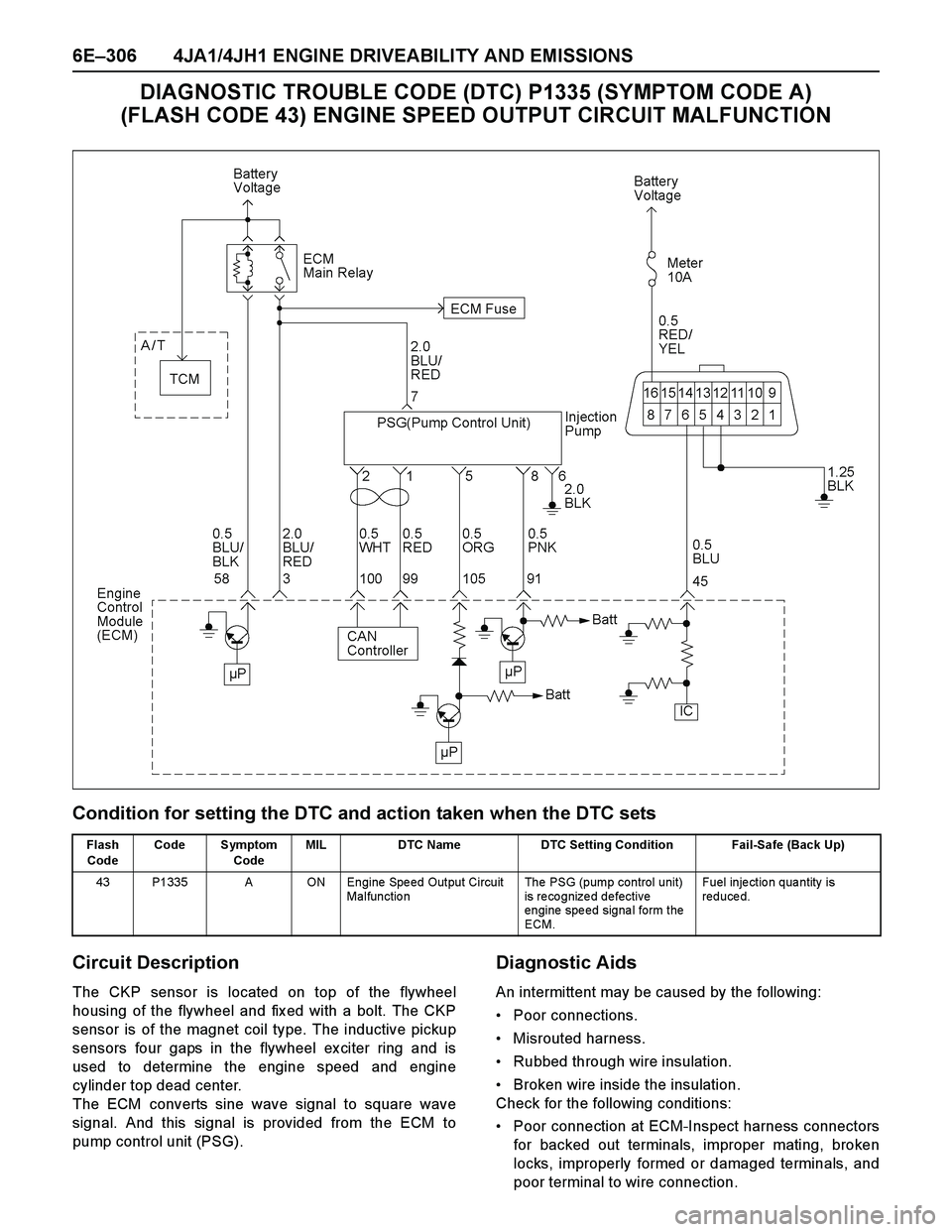
6E–306 4JA1/4JH1 ENGINE DRIVEABILITY AND EMISSIONS
DIAGNOSTIC TROUBLE CODE (DTC) P1335 (SYMPTOM CODE A)
(FLASH CODE 43) ENGINE SPEED OUTPUT CIRCUIT MALFUNCTION
Condition for setting the DTC and action taken when the DTC sets
Circuit Description
The CKP sensor is located on top of the flywheel
housing of the flywheel and fix ed with a bolt. The CKP
sensor is of the magnet coil type. The inductive pickup
sensors four gaps in the flywheel ex citer ring and is
used to determine the engine speed and engine
cylinder top dead center.
The ECM converts sine wave signal to square wave
signal. And this signal is provided from the ECM to
pump control unit (PSG).
Diagnostic Aids
An intermittent may be caused by the following:
Poor connections.
Misrouted harness.
Rubbed through wire insulation.
Broken wire inside the insulation.
Check for the following conditions:
Poor connection at ECM-Inspect harness connectors
for backed out terminals, improper mating, broken
locks, improperly formed or damaged terminals, and
poor terminal to wire connection.
Flash
CodeCode Symptom
CodeMIL DTC Name DTC Setting Condition Fail-Safe (Back Up)
43 P1335 A ON Engine Speed Output Circuit
Malfunctio nThe PSG (pump control unit)
is recognized defective
engine speed signal form the
ECM.Fuel inje ctio n qua ntity is
reduced.
Page 1712 of 4264
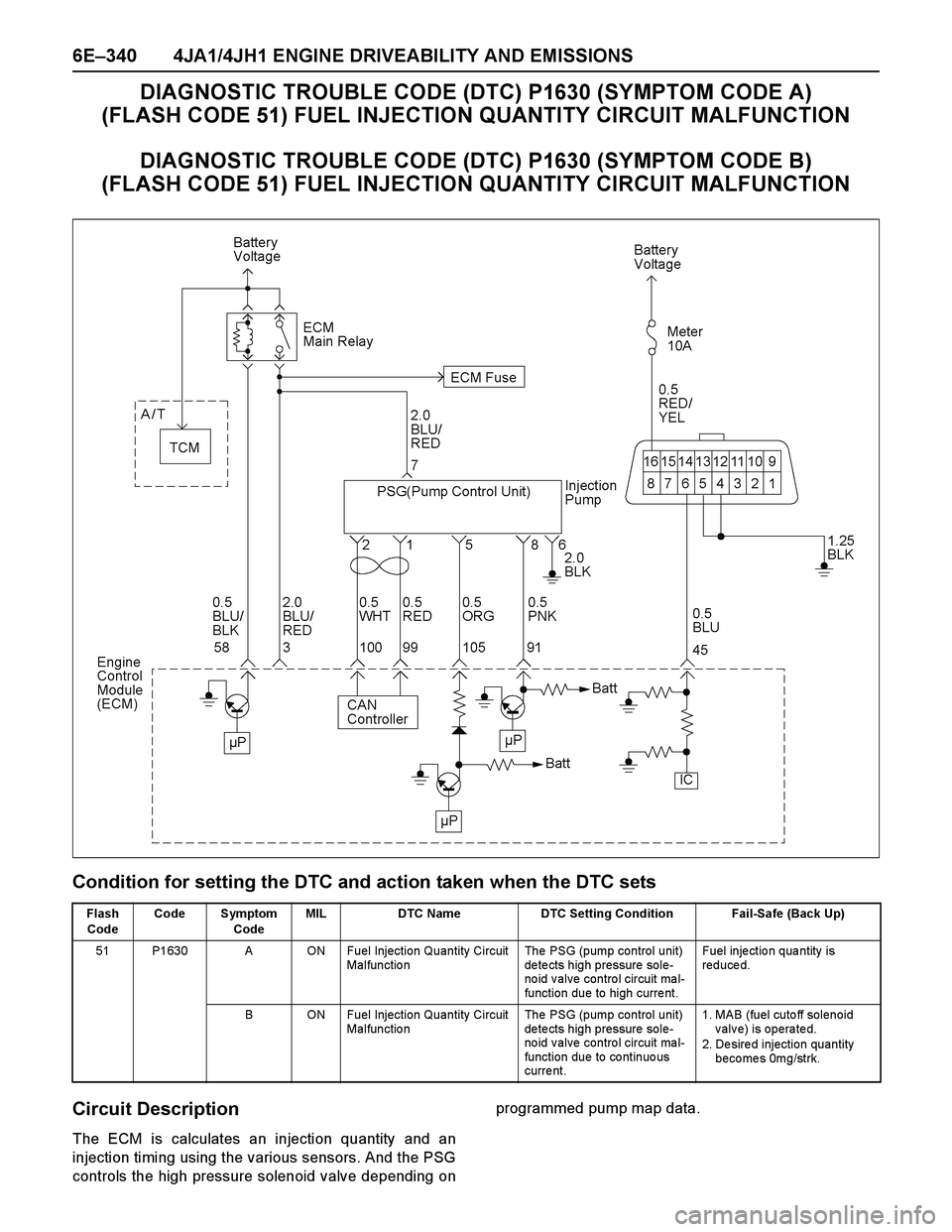
6E–340 4JA1/4JH1 ENGINE DRIVEABILITY AND EMISSIONS
DIAGNOSTIC TROUBLE CODE (DTC) P1630 (SYMPTOM CODE A)
(FLASH CODE 51) FUEL INJECTION QUANTITY CIRCUIT MALFUNCTION
DIAGNOSTIC TROUBLE CODE (DTC) P1630 (SYMPTOM CODE B)
(FLASH CODE 51) FUEL INJECTION QUANTITY CIRCUIT MALFUNCTION
Condition for setting the DTC and action taken when the DTC sets
Circuit Description
The ECM is calculates an injection quantity and an
injection timing using the various sensors. And the PSG
controls the high pressure solenoid valve depending onprogrammed pump map data.
Flash
CodeCode Symptom
CodeMIL DTC Name DTC Setting Condition Fail-Safe (Back Up)
51 P1630 A ON Fuel Injection Quantity Circuit
Malfunctio nThe PSG (pump control unit)
de te cts high pressure sole-
no id v alve contro l circuit ma l-
function due to high curre nt.Fuel inje ctio n qua ntity is
reduced.
B ON Fuel Injection Quantity Circuit
Malfunctio nThe PSG (pump control unit)
de te cts high pressure sole-
no id v alve contro l circuit ma l-
function due to co ntinuo us
curre nt.1. MAB (fuel cutoff solenoid
valve) is operated.
2. Desired injection quantity
becomes 0mg/strk.
Page 1713 of 4264

4JA1/4JH1 ENGINE DRIVEABILITY AND EMISSIONS 6E–341
Diagnostic Aids
An intermittent may be caused by the following:
Poor connections.
Misrouted harness.
Rubbed through wire insulation.Broken wire inside the insulation.
Check for the following conditions:
Poor connection at ECM and PSG-Inspect harness
connectors for backed out terminals, improper
mating, broken locks, improperly formed or damaged
terminals, and poor terminal to wire connection.
Diagnostic Trouble Code (DTC) P1630 (Sy mptom Code A) (Flash Code 51) Fuel
Injection Quantity Circuit Malfunction
Diagnostic Trouble Code (DTC) P1630 (Sy mptom Code B) (Flash Code 51) Fuel
Injection Quantity Circuit Malfunction
Step Action Value(s) Yes No
1Was the “On-Board Diagnostic (OBD) System Check”
performed?
—Go to Step 2Go to On Board
Diagnostic
(OBD) System
Check
2 1. Connect the Tech 2.
2. Review and record the failure information.
3. Select “F0: Read DTC Infor As Stored By ECU” in
“F0: Diagnostic Trouble Codes”.
Is the DTC P1630 (Symptom Code A) or P1630
(symptom Code B) stored as “Present Failure”?—Go to Step 3Refer to
Diagnostic Aids
and Go to Step
3
3 1. Using the Tech 2, ignition “On” and engine “Off”.
2. Select “F1: Clear DTC Information” in “F0:
Diagnostic Trouble Codes” with the Tech 2 and
clear the DTC information.
3. Operate the vehicle and monitor the “F0: Read
DTC Infor As Stored By ECU” in the “F0:
Diagnostic Trouble Codes”.
Was the DTC P1630 (Symptom Code A) or P1630
(symptom Code B) stored in this ignition cycle?—Go to Step 4Refer to
Diagnostic Aids
4 Replace the injection pump assembly.
Is the action complete?—Verify repair—
Page 1721 of 4264
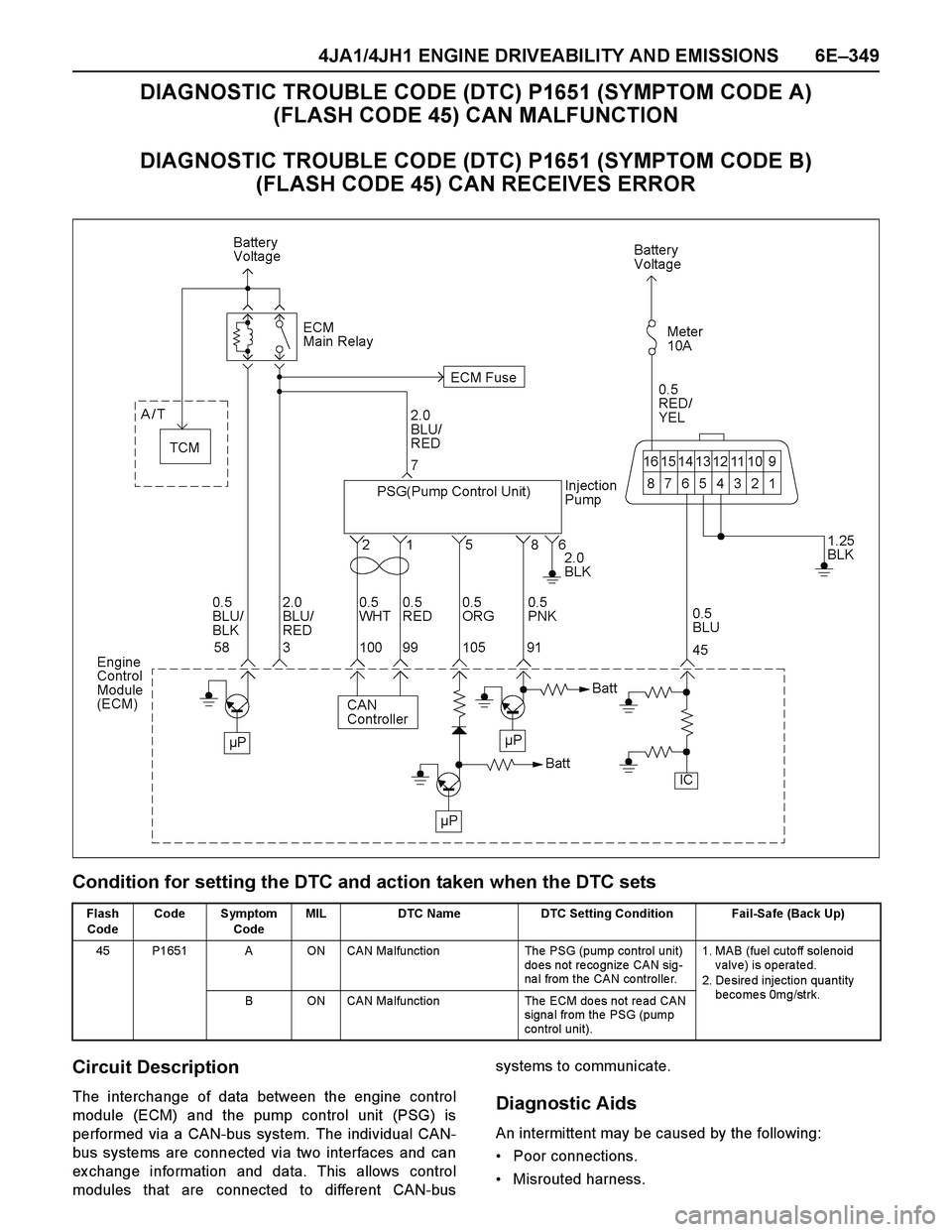
4JA1/4JH1 ENGINE DRIVEABILITY AND EMISSIONS 6E–349
DIAGNOSTIC TROUBLE CODE (DTC) P1651 (SYMPTOM CODE A)
(FLASH CODE 45) CAN MALFUNCTION
DIAGNOSTIC TROUBLE CODE (DTC) P1651 (SYMPTOM CODE B)
(FLASH CODE 45) CAN RECEIVES ERROR
Condition for setting the DTC and action taken when the DTC sets
Circuit Description
The interchange of data between the engine control
module (ECM) and the pump control unit (PSG) is
performed via a CAN-bus system. The individual CAN-
bus systems are connected via two interfaces and can
ex change information and data. This allows control
modules that are connected to different CAN-bussystems to communicate. Diagnostic Aids
An intermittent may be caused by the following:
Poor connections.
Misrouted harness.
Flash
CodeCode Symptom
CodeMIL DTC Name DTC Setting Condition Fail-Safe (Back Up)
45 P1651 A ON CAN Ma lfunction The PSG (pump control unit)
do es not re co gnize CAN sig-
na l from the CAN co ntrolle r.1. MAB (fuel cutoff solenoid
valve) is operated.
2. Desired injection quantity
becomes 0mg/strk.
B ON CAN Ma lfunction The ECM do es not re ad CAN
signal from the PSG (pump
control unit).